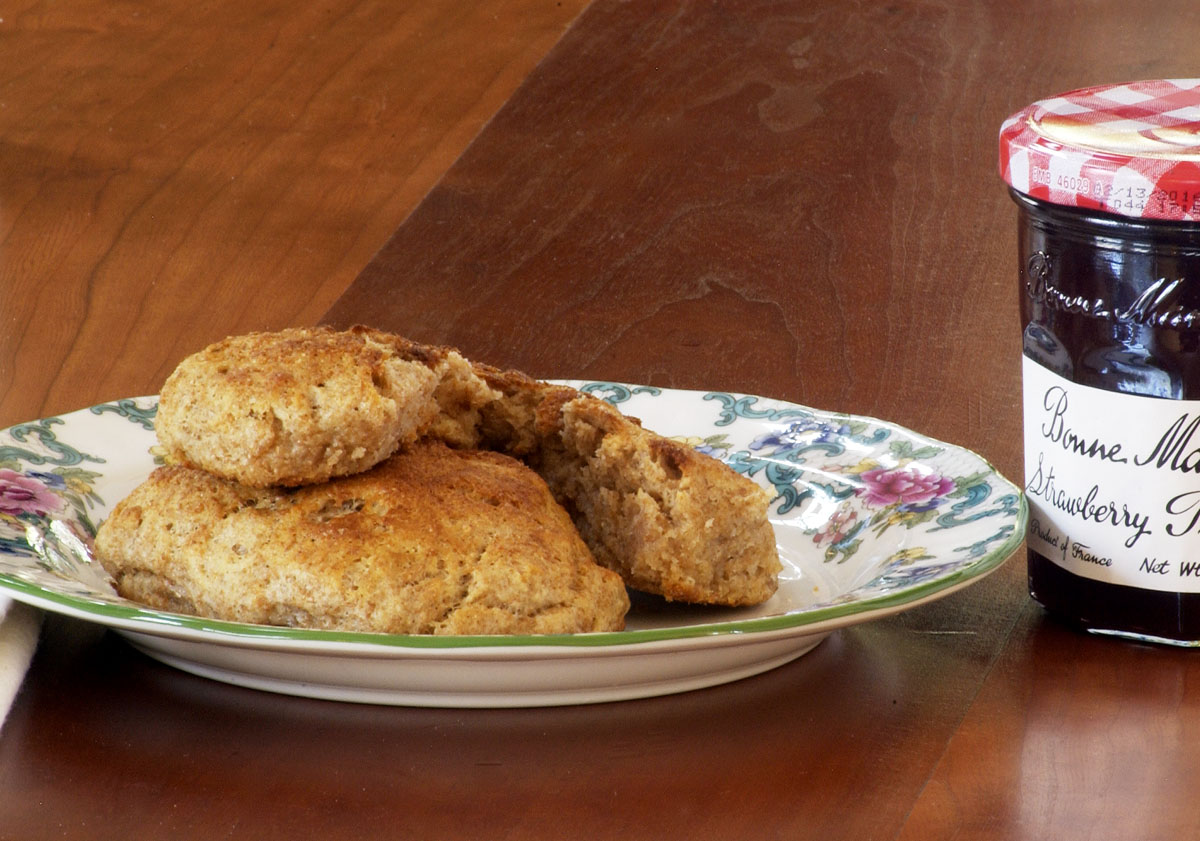I love the taste of organic stone-ground whole-wheat. It tastes like wheat, and I love wheat. I also make no apologies to anti-gluten partisans, because I think that good wheat breads baked at home from good organic flour are not at all the same thing as commercial baked goods. I’ll leave it as an exercise for the reader to Google for the difference between stone-ground flour and ordinary whole-wheat flour and how they are milled. But there is an easily detectable difference in taste. Ordinary whole-wheat flour often has a bitterness, or what country folks disdain as having a “whang” about it. Stone-ground whole wheat flour has no whang. It tastes like honest wheat, which is what it is.
But the problem with stone-ground whole-wheat flour is that it is very hard to work with. The bran is rough and dry. Unless you use baking techniques optimized for stone-ground flour, your baked items are likely to end up hard and dry. The easy and fast method is to combine the stone-ground flour with whatever portion of unbleached flour your conscience will permit.
Artisan bakers of yeast and sourdough breads who work with stone-ground flour insist on soaking the flour before using it. That softens the bran, encourages some beneficial chemical processes, and makes a tastier, better-rising bread. You also need to get as much moisture into the bread as possible. Surely, I thought, the same concepts can be applied to quick-breads like biscuits.
As usual, I apologize for not usually giving specific recipes here. Part of the reason is that I rarely use exact recipes for things that I make frequently. Another reason is that this is about a concept — the concept of making quick-bread with stone-ground flour. I’m assuming that you’re already an experienced biscuit-maker and that you already have a method or a recipe.
The night before you make the biscuits, mix your stone-ground whole-wheat flour with milk (or buttermilk). We’re going to add more liquid in the morning, so use only enough milk to satisfy the thirst of the flour while keeping the mixture fairly stiff. Also add a teaspoon to a tablespoon of apple cider vinegar, depending on how large a batch of biscuits you’re making. Put this in the refrigerator, covered, overnight.
The usual method of mixing biscuits completely falls apart if you’re starting with wet flour. I suppose you could mix your shortening into the flour before the soak, but I don’t. Take your flour mixture out of the refrigerator early to let it come to room temperature. Cut your shortening into small pieces (I use butter) and use your hand to mix the shortening into the flour mixture. This will take some patience, but small lumps are OK.
Now the objective is to get a bit more liquid mixed into the dough, along with the salt and baking powder. Cutting the dough into pieces (leave it in the bowl) might help here. Add the baking powder and salt. Add more buttermilk if you used buttermilk, or heavy cream if you used milk the night before. The thickness of the buttermilk or cream helps get more moisture into the dough. You should end up with a moist biscuit dough. Shape the dough into biscuits as you usually would.
I bake the biscuits at 450 degrees using the bread function of the Cuisinart oven, which injects steam into the oven for the first seven minutes of baking. This helps keep moisture in the biscuits and improves oven spring. If you don’t have a steam oven, flinging a little water into the oven or having a shallow pan of water in the oven during pre-heating can’t hurt.
Biscuits made this way are some of the tastiest, most tender biscuits I’ve ever made, no lie.
By the way: Over the years, when I’ve discussed biscuit-making with inexperienced or casual bakers, I’m surprised how many people are completely unclear on the concept of what “self-rising” flour is. Some people think that there is something magical or special about self-rising flour and that it’s the only kind of flour from which biscuits can be made. But self-rising flour is just flour to which leavening agents such as soda and baking powder already have been added. Any biscuit recipe that starts with “plain” flour will tell you how much soda or baking powder to use per cup of flour. King Arthur makes an unbleached self-rising flour, but I have never used that, or any, self-rising flour. Self-rising flour seems like a useless convenience, as far as I’m concerned, especially since I use potassium-based, no-sodium baking powder like the baking powder sold by Hain.


do you ever make scones and add your orchard apples?
Hi Henry… My 7-year-old orchard still barely makes apples faster than the squirrels can carry them off, but I’m hoping for a good year this year. Last season I had apples enough for two pies, and that was about it.
I do tend to re-read posts. Just noticed your good taste in preserves. I discovered Bonne Maman Fig Preserves a few years ago and am never without them.
I don’t think I’ve seen the fig preserves. I must look for that…